I’m a context guy. What I mean by that is I like to must see the big picture. Some might call it the bottom line. Whatever. If I don’t see the greater context, I struggle with listening to the details. It’s like some form of torture, where I’ve been tied to a chair and have to listen to the endless explanation of some fraction of a micro-concept. Just mind-numbing.
So, for me to explain myself better in this blog (and continue the revolution), I have to set the context. For the blog. For my whole philosophy. For the modern profession of selling.
And the context is this.
We are the lucky few, in the entire history of mankind, who have been given the chance to live through MASSIVE change. And not just change, but literally a global shift in what we commonly call “ages.”
Pause. Think about that for a moment. We use the term “ages” to describe some pretty cool things. The Stone Age. The Iron Age. The Age of Reason. The Age of Aquarius (sorry – I couldn’t resist).
Ages transcend generations. They transcend geopolitical boundaries. Shucks, they don’t just transcend them – they transform them. And economies, too. Which is why I’m going there (since this is a mostly-sales blog).
So back to the rant topic at hand. As the infographic below shows (Lord, I hope it got attached – don’t even get me started on my technical deficiencies. Starting this blog was hard enough), the most recent ages we have dealt with (and was prominently displayed for us at the Opening Ceremony of the London Olympics) are the Agrarian Age (from as early as 10,000 BC to the early 1700’s AD), 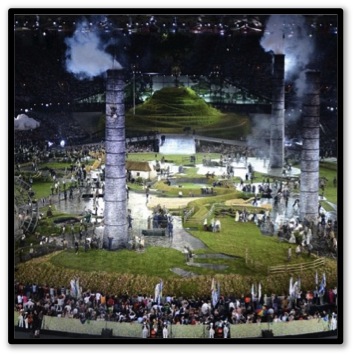 which gave way to the Industrial Age (from the mid 1700’s AD to late 1900’s AD), which has now given way to the Information Age (late 1900’s AD to current). Or as the Olympics tried to brainwash tell us, enabled digital technology so that we could listen to British rock (and since U2 is Irish, I say “rubbish” to the whole lot).
which gave way to the Industrial Age (from the mid 1700’s AD to late 1900’s AD), which has now given way to the Information Age (late 1900’s AD to current). Or as the Olympics tried to brainwash tell us, enabled digital technology so that we could listen to British rock (and since U2 is Irish, I say “rubbish” to the whole lot).
What’s the big deal? Simple. The transition from Agrarian Age to Industrial Age was full of upheaval. Some might even say it was chaotic. And that is the point I am making now. About the current transition. From Industrial Age to Information Age, that is.
You see, every time I hear some leader try to tell me how to leverage an Industrial Age solution to make an Information Age problem go away, I think to myself, “This guy’s trying to sell me a loom. An honest to goodness LOOM. 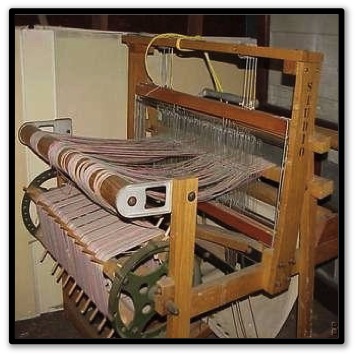 With steam-powered attachments.” I shudder even now as I think about it. What in Miss Molly’s underwear drawer are they thinking?! Get away from me, 1900’s thinking! And take your pencils, telegraph, and sales funnel with you! You are just creating more chaos. Clearly, sir (or madam), you do not understand the chaos of the current Age.
With steam-powered attachments.” I shudder even now as I think about it. What in Miss Molly’s underwear drawer are they thinking?! Get away from me, 1900’s thinking! And take your pencils, telegraph, and sales funnel with you! You are just creating more chaos. Clearly, sir (or madam), you do not understand the chaos of the current Age.
And how does one understand this chaos? By understanding the threads that create it. By looking at the patterns that appear in each age and analyzing how the patterns have evolved. By identifying where old rules have become outdated so that new rules can take their place.
Since I am not some full-blown futurist, I can only speak to the threads that tie directly to generating revenue in the swirling mass of today’s chaos. And of those, I would like to highlight the following six topics:
- The economic philosophy (of each age)
- The key economic generator (of each age)
- Where to find customers (in each age)
- The phases of labor (of each age)
- The target of innovation (for each age)
- The source of energy and thrust (in each age)
Obviously, you can see some of my thoughts already in the infographic that I hope was successfully added to this post (I’m still twitching from the g-force on my learning curve here). But I will also tackle each topic individually, sharing my own observations and dumb-luck discoveries research, over the coming weeks. My hope is that by understanding how the chaos works, we can all begin to harness it. And actually enjoy it for a change.
I mua… Onward and upward.

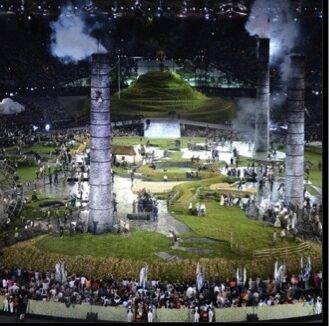
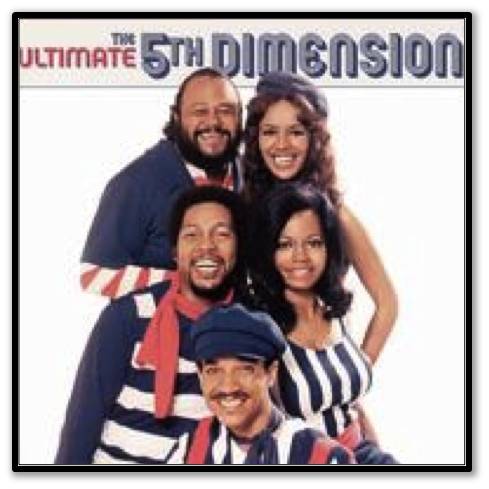
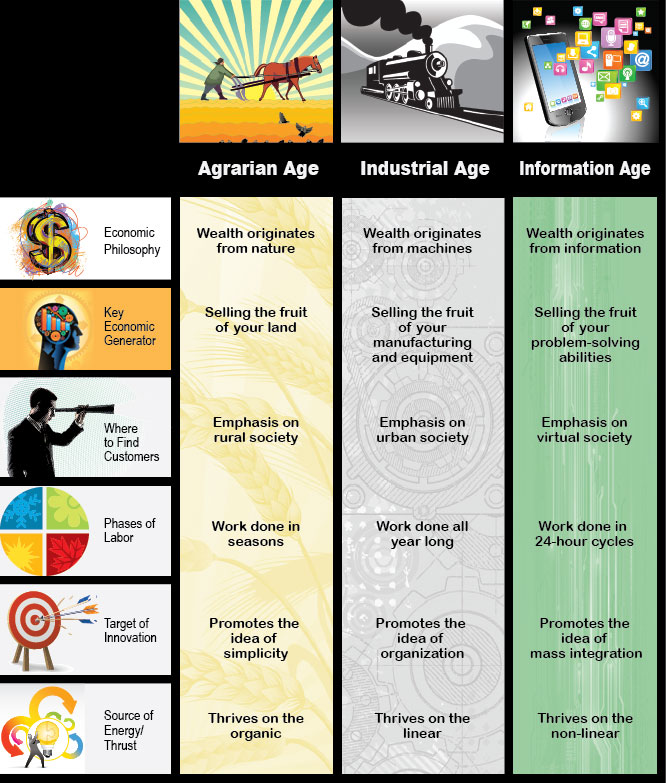
Interesting blog. A nice touch on generations study, helps in understanding people’s need as both customers and employees. Very useful in identifying markets.
Thanks, Jim. Check the blog out in the coming weeks as I get deeper into what these concepts mean, especially in relation to the modern concept of selling.
Jim, next blog is out. Thanks.
Great blog post! I couldn’t agree more, we are living in a massive change! All the mentioned characteristics are really spot on. I’d like to add a few thoughts:
Wasn’t the industrial age dominated by competitiveness instead of collaboration? Real collaboration which means creating value cross-functionally, globally, with partners and sometimes competitors is the way to go to help customers to achieve their desired outcomes. Additionally, I assume that the information age is setting the frameworks to enable this kind of deeper collaboration, but the real value will be created in the future – the conceptual age.
Aren’t we already on the way to the conceptual age?
Collaboration is especially for sales people a real challenge, because many sales reps in many industries were often more trained on how to respond to the competitors instead of how to keep a clear focus on the customer outcomes.
Let me add some context regarding the conceptional age – for you as the context guy (I love that, something you have in common with Brian, right?):
I’d like to add a few characteristics, such as meaningful work, purpose-driven work, serving all kinds of stakeholders, not only shareholders, and the relevance of system-thinking and the relevance of design-thinking (see also Dan Pink: A Whole New Mind).
The “right-brains” will rule the future…
Tamara, I think that collaboration was a part of every Age, but that massive competitiveness (as you describe) is a sign of the decline of the Age. Perhaps it is this very competitiveness that is the very cauldron of a new Age. I think of it this way: Once innovation reaches a genuinely new level of evolution, it becomes harder and harder for the guardians of the old Age to stay relevant. So, they become cannibalistic, competing with and consuming everything they can to sustain their (often bloated) existence. The real geniuses are the ones who embrace the innovation and drive collaboration on their own.
In terms of the Conceptual Age, I don’t see it as a new Age at all. It is just the more developed version of the Information Age (which, I think is still in its early days). I think that (maybe) we are on the path of moving away from defining information in such concrete terms and will reach a state where technology will actually think alongside of us – and not just reflect/capture our thinking for us. But in order for this to happen, technology must be able to operate with concepts. And when that day happens, the Information Age will be in full blossom. Or so the voices in my head tell me…
Thoughts?
Tim, thanks for your response!
I think competitiveness was a logical consequence based on the industrial age’s general design point: from the inside to the outside.
In the meantime, we try to design selling systems consequently (!) backwards from the customer (buyer roles, customer’s journey), from the outside to the inside, focused on meaning, purpose and the value we can create for customers, in order to enable them to achieve their outcomes. It’s the shift from outputs to outcomes, from what services DO to what services MEAN (focused on complex sale). I agree to your view point, that an additional increase of competitiveness Could also be a sign of the decline of the age.
Yes, the conceptual age is built on the information age. Whether you want to call it a new age or not – I think, it doesn’t matter. The most important point here is to create context, meaning and relevance around all the information we have with all the technology we currently use.
Let’s create that transformation!
Hey, Tamara. You got me thinking with your comment on meaning. In my latest blog, I danced around the idea that consumption has meaning. In other words, what we consume is driven by the desire to achieve something as a result of that consumption. This makes me think of Maslow. Have you ever thought about a hierarchy of meaning of some sorts? In other words, layering the meaning that customers are seeking and defining the elements required for achieving that meaning?
Thanks
Tim, fascinating stuff for sure and I believe your infographic is “directionally correct,” inasmuch as any sweeping generalization can be (as a concept geek and analyst myself, I constantly have to remind myself that the “map is not the territory”). I completely agree that major shifts have occurred and are occurring, but as much as the pace seems blindingly fast, based on the overload of information now available to us, people like Dan Burris have convinced me that we can see it coming for a long time , and the actual change is a lot slower than it sometimes feels. Certainly, to me, the Sales reaction to all this change seems somewhat slower than a glacial pace.
The “chaos” to me, is what FranklinCovey calls the “100 mph whirlwind” of daily work life. I believe it, too, did grow slowly, but that certainly is a massive change between now and the middle of the Industrial Age. And while the speed did increase gradually over time, it has certainly far-outpaced our ability to stay on top of it all. The whirlwind/chaos is the stuff you walk back into after a strategic planning session, or after a training session, that chews your time, distorts your perspective, wears you down, and overwhelms you to the point where urgent trumps important and the best-laid plans are pushed off-track. Andrew Carnegie, sitting in his office, focused on growing his empire, was better able to focus and execute, possibly as a result of his personal wiring, but also certainly as a result of a different environment where information wasn’t flying at him faster than he could absorb it. The human brain hasn’t evolved fast enough to keep up with the constant flow of information, the constant connectivity, or the overwhelm or distraction it creates. Worse, our desire to hang onto the status quo slows us down, along with the the legacy systems of society, commerce, government, and our economic engine in general, which can’t withstand radical change without huge negative impacts.
I liken all this talk of change to the morphing of training delivery methods. I remember reading 15 years ago that classroom learning was going to be dead in a few years, to be entirely replaced e-learning. Turns out that, for now, e-learning in its various forms simply provides additional intelligent options for delivery, based on the costs and strengths of each method. Yet, air travel hasn’t died, conventions thrive, training and selling still does occur face-to-face, and the change drags along. Is it morphing? You bet. Will any of those things die in 2013? I don’t think so. Do we need to better adapt and cope with the changes in the Information Age, the shift to a buyer-centric market, to constant connectivity, to the gaggle of growing information on the Internet, to social networks, to economic crises, and the chaos they all create? You bet we do.
But at least for now, I’m of the mind that we need methods, tools, and strategies to cope with the change, because I don’t believe that humans, barring some unforeseen some medical or technological intervention, will ever be able to evolve quickly enough to “adapt” to the changes we are facing right now. In fact, I think the next great breakthroughs in technology will come in the form of technology that considers our current limited brain-state and helps us find and use the exact right information, exactly when we need it. I also find the ongoing energy implications of the Information Age to be a concerning and fascinating issue, but that’s a topic for another day or different blog.
In any case, Tim, I look forward to your future posts to help your readers and me sort through all of it and constantly evolve to better harness and thrive in the chaos. Slowly. 😉
Thank you, Mike, for weighing in.
My first thought after reading your response is a question: do people, and more specifically sales leaders, HAVE to recognize the change from one Age to another before anything else can be done? Or can they adapt slowly because their own market is not changing (in any discernable way)? In other words, does your customer base determine your rate of change (or should you drive change a la Apple)?
(okay, so my “first thought” was actually a series of multiple questions…)
Tim: “…do people, and more specifically sales leaders, HAVE to recognize the change from one Age to another before anything else can be done? ”
Mike: Do they HAVE to? No. Most people are caught up in the whirlwind and adapt as external forces dictate or demand. And I think it’s wise to recognize that change is not the same everywhere. External forces may exert different pressures at different times in different companies or industries, or sales nuances. SHOULD they? I would generally think it’s wise, but often the first one through the door gets the bloody nose. It varies, of course, but first-mover advantage is frequently over-rated, in my opinion. (If I remember right, Beta came out before VHS.) I also think it’s different (or, I should say, “may be”) if you’re selling nuts and bolts vs. enterprise software.
Tim: “In other words, does your customer base determine your rate of change (or should you drive change a la Apple)?”
Mike: Yes, and I don’t know. I believe your customer base, or future target customer base, or your calculated-risk assumptions about where your market is headed, should always weigh heavily into your strategic direction and tactical plans for change. Regarding being Apple-like, I’m not sure I have a generalized opinion. I’m certainly for, vs. against, innovation, so I lean toward “yes.” But if I’m making and selling paper plates, I’m not sure how much R&D funding I’m going to invest in a personal force field device that attaches to your belt or shirt and holds food floating at chest level, suspended in air, for you to eat it, without paper and with minimized clean up or reduced washing expenses. Although it might be a pretty green idea, I’m probably better off in the short-term in maximizing the cost benefits of Lean and Six Sigma to be the most efficient producer, drive down costs, sell at a low-price through channels at a better margin, with current paper technology, while I work on things in the background, as technology develops that will enable things like that crazy idea I just cooked up. (Bad pun intended.)
Not sure if that all made sense, but it’s near dinner on a Saturday and blood sugar levels are dropping. That’s my excuse and I’m sticking to it.
Now. where are those paper plates…?
First off, I love your infographic. I’m jealous. So here I am picking nits, and sharing my two cents.
I might retitle “economic philosophy” to read “economic drivers.” In my mind, the economic philosophy that we (successful) humans have adopted has been western capitalism (free markets), at least throughout the last two periods covered by your infographic.
The economic driver of the agrarian age was the wealth created from human labor being added to the land. Nature may have provided the wealth, but it took man’s labor to make it as valuable as we have.
In the industrial age the economic driver was the supplementation of human labor by machines to improve the yield of all forms of our physical labor, mostly the creation of goods. And a lot of goods that made our lives better and easier than we might have ever imagined (But for the those that did the imagining, where would now be?)
In the information age, we are adding economic value by leveraging new machines to improve our ability to think. In my mind, the really, really, really big change in this age is that the way economic value is being created is by using computers to do for our mental processes (our brains) what machines did for our bodies (our backs). That, and the fact that we were so successful in the first two of your ages that all of our basic needs are so easily met, that the value we are seeking is very different than what we needed as value in the past (i.e. if you are starving, you don’t need an iPad mini).
I am a futurist, but here isn’t the place to discuss the trajectory of value creation and the implications for the future of mankind. But suffice it to say, it’s only going to get better from here. But you’re right; it’s going to be more and more chaotic on the way. And it’s going to take a terrible toll on those that try to swim against the tide (as it always has been).
Welcome to the community, Tim! Can’t wait to read more!
Thanks for joining the discussion, Anthony. I am definitely looking forward to more conversations.
I chose “philosophy” because I see so much in the thinking from each Age that genuinely reflects a pure, philosophical approach to generating wealth. I will kick that around further in the next blog, but two quick ideas. One, the belief that wealth is desirable is definitely a philosophical concept. Two, how that wealth is attained from other sources spurs more philosophical thought (e.g. Does nature exist as my possession? Is the external world something that is harnessed or conquered? Is wealth a formula that, with the right combination of drivers, can be produced at will? Etc.).
Perhaps I’m the one picking nits, but it seems to me that the philosophical tones are becoming more widespread as a greater number of people attain basic needs more easily (which is also a link to how/why the champions of each Age thought the way that they did/do). Which pulls me lock step into your other point on how the very concept of value is being redefined. Even as I travel in Asia and Africa (most recent trips), I see major acceleration in the thinking of younger generations – away from traditional thought and rules. Have you seen similar patterns?
To talk about ages, one typically needs to define the underlying variable. A typical one is ‘human occupations’ (vs weapons, etc.), which did indeed change dramatically across the ages you describe. But, such ages actually began with ‘hunter-gatherers’ even before the Agrarian Age.
Many of above trends and activities you mention, e.g., collaboration, are considered to be harbingers of the next, already emerging age, the post-industrial, K Age. In that age, robots and drones will replace the traditional make and move functions and IT will certainly aid humans in formerly white collar tasks. But, at its core, knowledge will become the great differentiator going forward.
Interesting, Doug. Are you saying that the emergence of robotic technology is a different age? I would see it as the continued evolution of the Information Age, where the physical efforts of the economy is being replaced through automation, as the knowledge-based efforts of the economy are ramped up and explored.